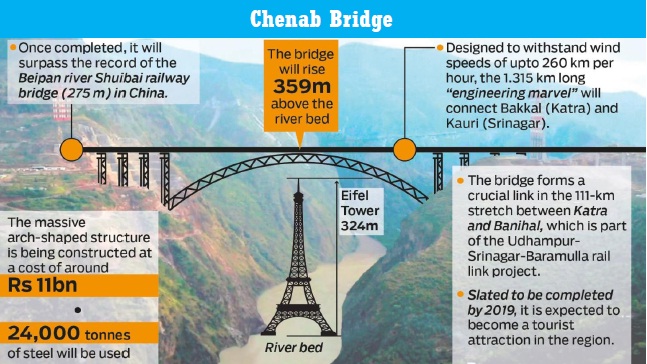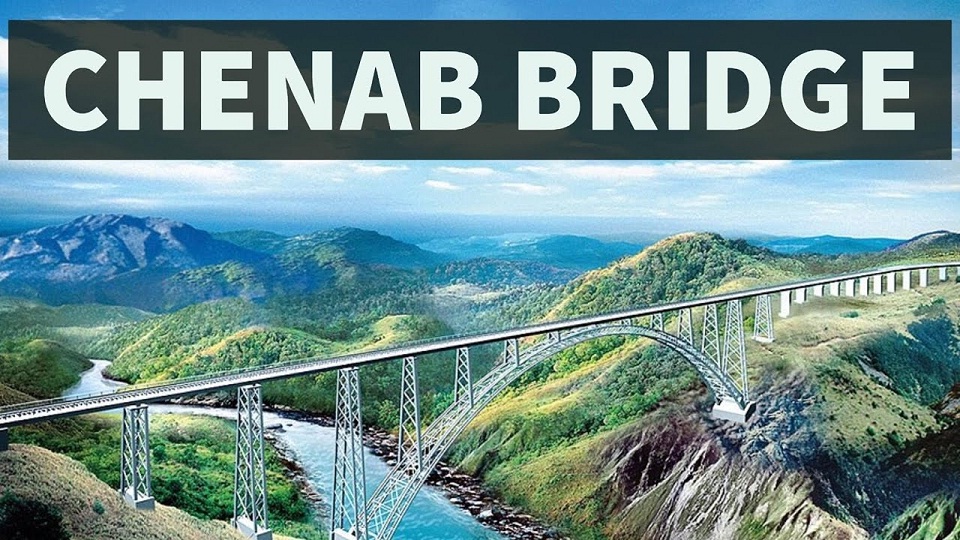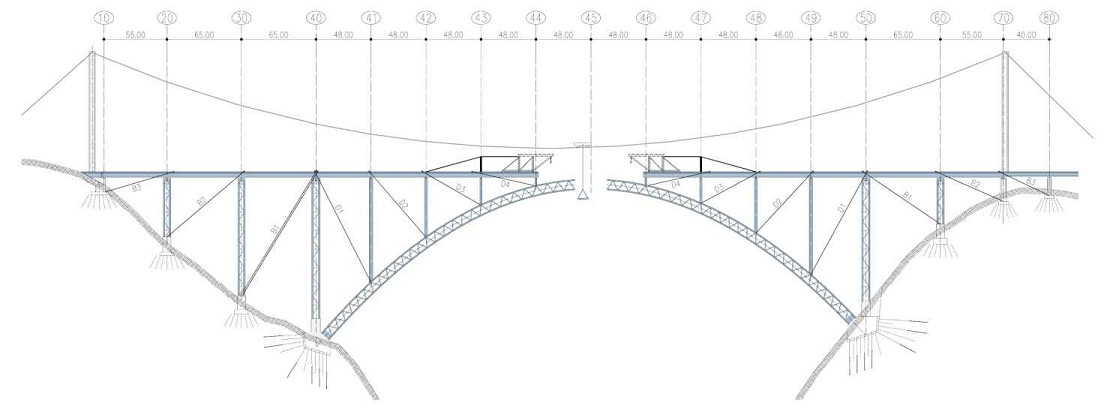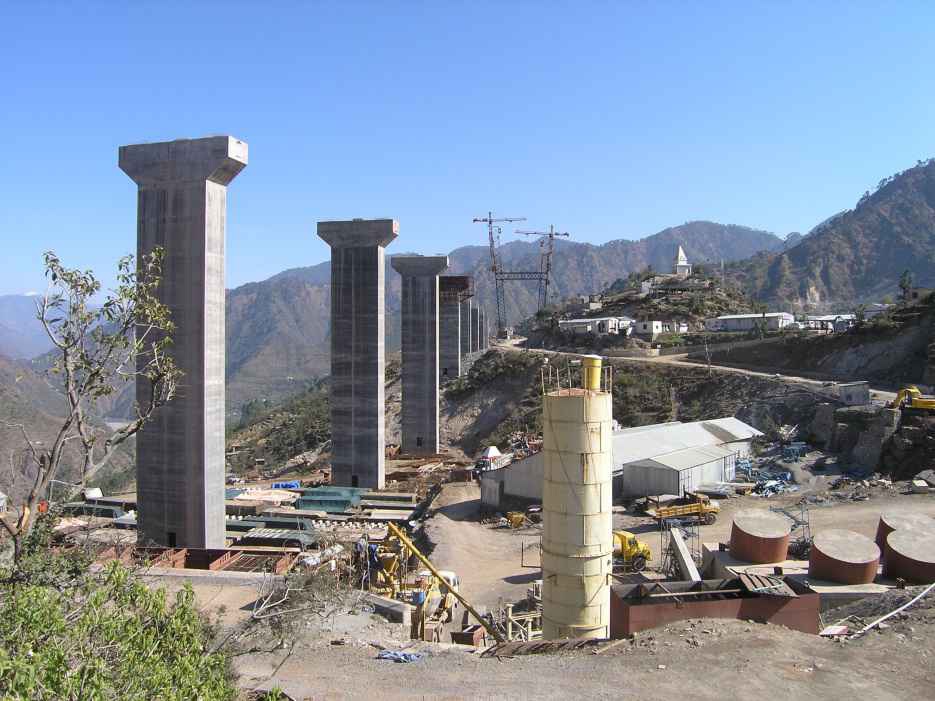





Published on Nov 07, 2018
The Chenab Bridge is a railway steel and concrete arch bridge under construction between Bakkal and Kauri in the Reasi district of Jammu and Kashmir in India. When finished, the bridge will span the Chenab River at a height of 359 m (1,178 ft) above the river, making it the world's highest rail bridge.In November 2017 the base supports were declared completed allowing for the start of the construction of the main arch . The bridge is scheduled to open in 20 19 though that seems highly optimisitic.
The upcoming Chenab bridge on the Katra-Quazigund section of the Udhampur-Srinagar-Baramulla Rail Link will be the highest bridge in the world once completed.
According to Northern Railway, the bridge -- being constructed at an imposing height of 359 metres -- will span a total length of 1,315 metres and require 25,000 metric tonnes of steel. The work, currently in progress near the Salal Hydro Power Dam, will cost a whopping Rs.512 crore.
In addition to indigenous expertise of the Indian Railways’ Research Design Standards Organisation, Konkan Railway Corporation, National Institute of Rock Mechanics (Kolar), Indian Institute of Technology (Roorkee) and Indian Institute of Science (Bangalore), international inputs have been drawn from various agencies in Finland, Austria, Germany, the US, England, Norway and South Africa.
To ascertain the stability of the bridge under extremely windy conditions, wind tunnelling tests were conducted in Norway where similar conditions were simulated in a laboratory.
As part of the construction work, two pylons of 130 metres and 100 metres height will be raised on either side of the river and a self-propelled auxiliary crane will run on the carrying ropes across these pylons. The access roads required for the construction of the bridge have been completed on both sides.

• Deck height (height above river): 359 m (1,178 ft)
• Bridge length: 1,315 m (4,314 ft), including the 650 m (2,130 ft) long viaduct on the northern side
• Arch span: 467 m (1,532 ft)
• Arch length: 480 m (1,570 ft)
This makes the Chenab Bridge:
• The world's highest railway bridge
• The bridge with the widest span in the Indian broad gauge railway network

Chenab is one of the major rivers of Indus Valley originating from Lahul Spiti in Himachal Pradesh and flowing westwards through J&K. Pir-panjal ranges are very steep. The horizontal distance from River Chenab to Kashmir Valley near Banihal/Qazigund is hardly 40 to 50 km, whereas the level difference to the nearest access to Kashmir Valley is about 1000 m. The choosing of rail alignment along the National Highway 1-A appears to have been therefore ruled-out. The British engineers and later Geological Survey of India did study this alignment but could not connect it for requisite parameters.
Northern Railway has undertaken the mega-project of constructing a new railway line across the Indian state of Jammu and Kashmir between the towns of Udhampur near Jammu and Baramulla on the northwestern edge of the Kashmir Valley. This project has been declared a national project in 2002. It is directed by the Northern Railway.
The extraordinary challenge lies in a large number of tunnels (totalling 63 km in length[10]) and bridges (7.5 km) to be implemented in highly rugged and mountainous terrain, with the difficult Himalayan geology. The most difficult part is believed to be the crossing of the deep gorge of the Chenab River, near Salal Hydro Power Dam, by the Chenab Bridge.
Another, smaller, arch bridge proposed in the new railway line was 657 m (2,156 ft) long, 189 m (620 ft) high Anji Khad Bridge between Katra and Reasi over the Raavi river. This proposal has been abandoned by the railways due to the specific geology of the location and a cable-stayed bridge is proposed.
After many deliberations, taking into account aesthetics, economy, and availability of local expertise and construction materials, the Chenab Bridge was designed as a large span single arch steel bridge with approach viaducts on either side. The arch is two-ribbed, fabricated from large steel trusses. The chords of the trusses are sealed steel boxes, internally stiffened and filled with concrete to assist in controlling wind-induced forces on the bridge. Another advantage of concrete filling is that internal painting will not be required.
The number of bearings has been minimized, particularly on the approach viaduct, through the use of continuous construction. This is advantageous, as it reduces the maintenance and inspection efforts, and improves the riding quality. The viaduct piers are of concrete, while the piers near the arch are of steel.
The design of major arch rail bridges requires considerations of a number of additional parameters, such as fatigue, global stability, second order effects, composite action, etc. It also requires that such a bridge is designed to achieve a consistent level of reliability for all load cases, and that the design standards match the construction standards. Indian construction standards such as the Indian Railway Standards (IRS), the Indian Road Congress (IRC) and the Indian Standards (IS) were found inadequate for the large spans of the Chenab Bridge. For example, the Indian Railway Standards (IRS) is primarily intended for simply supported bridges with spans up to 100m (although these have been successfully used for higher spans up to 154m). The spans for the Chenab Bridge greatly exceed this limit, and are continuous. Therefore, to assure a safe design, Indian national standards have been supplemented with International standards such as British Standards (BS), International Union of Railways (UIC) and Euro. Also, many experts throughout the globe, based on their versatile and relevant experience, have been involved in order to make the building project a success.

Following are some of the design considerations taken into account:
• Limit state philosophy of design has been decided to be followed as per BS codes
• Computation of wind load effects as per wind tunnel tests
• Site specific seismic spectra developed by Indian Institute of Technology (IIT) Roorkee
• Provision of Euro code 8 for ductility detailing of very tall and hollow rectangular RCC piers
• Provision of long welded rail (LWR) over the bridges and resulting force calculation as per UIC – 774-3R guidelines
• Blast resistant design has been used
• Design checking for fatigue as per BS codes
• Deformation limits as per comfort criteria of UIC – 776-2R and UIC 776 -3R guidelines
• Redundancy provided in the structures, for lower level of operation during mishaps and against collapse in extreme cases of one pier failure
The Quality aspect has been emphasized, as the quantum of fabrication and welding is colossal. Mostly indigenous material compliant to IS codes has been planned to be used, whereas for the design, international codes have been referred, which means the Quality Control work is still difficult.
The Chenab Bridge was originally intended to be completed in December 2009. However, in September 2008 the project was halted due to fears over the bridge's stability and safety.
Work on the bridge restarted in 2010 with the plan to complete it in 2015.

The construction has been given to Afcons Infrastructure Limited, a part of the Shapoorji Pallonji Group, the third-largest construction group in India.
The erection scheme for the bridge is a project in itself. Two pylons (about 130 m and 100 m high) were erected on either side of the river, and two auxiliary self-propelled cable cranes (capacity of 80t each) were used to tow temporary auxiliary ropes across these pylons. The ropes were used to support the partly finished arch parts. After arch completion, the trusses will be added, finally the girder will be constructed as a horizontal sliding type platform.
Nov 2017:The Work On Arch Bridge To Completed By May 2019
The steel structures of the bridge will be manufactured in workshops built in the mountains. The workshops have been moved to the building site, because there is no proper road network in the challenging terrain. The longest building parts that can be delivered to the site are 12 meters in length. Therefore, four workshops have been built in the mountains. Workshops and paint shops built next to them are located on both sides of the valley.
All steel materials, except for the smallest rolled profiles, are delivered to the mountains as steel boards. The insufficient infrastructure of the area causes additional problems. There is no electricity and the water of the river is not suitable for manufacturing concrete. All electricity must be produced at the site and the water is delivered from further away in the mountains
The job is also challenging because the track has curvature in the approach bridge. In this section, the construction stage bearings have been designed in such a way that it is possible to launch the steel deck in the curvature portion as well.
The bridge will consist of about 25000 tonnes of steel structures, the main portion of which will be used for the arch bridge section. First, a cable crane will be built over the valley for constructing the steel structures. The cable crane will move between pylon towers built on both sides of the valley. The crane can deliver a maximum amount of 40 tonnes of steel parts. For example, the over 100 meters long steel columns with bolted couplings will be constructed using this technique.
When the long steel columns are ready, the steel deck will be pushed on top of the columns. After this, a derrick crane, which is capable of lifting about 100 tonnes, will be placed on top of the deck.
The derrick will crane the arch segments from deck level to the erection front of the arch. Deck erection will proceed simultaneously with the erection of the arch. Both the arch and the deck cantilever freely by up to 48 metres. When the next arch pier location is reached, temporary cables will be installed to support the arch, and the new arch pier will be constructed on the free end. The superstructure can then be supported by the arch pier and so forth until the last arch pier is reached. The very last span of the arch and the elements of the key segment will again be delivered by the cable crane; closure of the superstructure is done by means of derrick erection.
The deck of the bridge will be welded in the workshop upside down in about 8 meters long sections, because the welding points in the final structure are mainly located under the bridge. When the job is completed, the sections are turned around and delivered to the next stage of the process.
The design of the main arch requires consideration of a number of additional parameters, such as fatigue, global stability, second order effects, composite action, etc. It also requires that such a bridge is designed to achieve a consistent level of reliability for all load cases, and that the design standards match the construction standards. That has been considered in the current design work as well.
The Chenab Bridge will be the biggest / the longest-span / the highest railway arch bridge ever built in the world. Its design offered great challenges to the design team, but the challenges will be even more demanding before the gap between the main arch halves is filled.